Over the last few days I have been hard at work on the 1903 Chinoiserie Promenade Dress (yes! It has an official name, date, and designation), and have realised how much I’ve bitten off.
Mostly I’ve been working on the skirt decoration. My design inspiration looked like this:
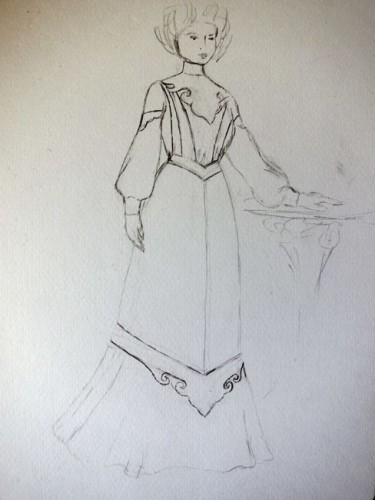
I played with other ideas:
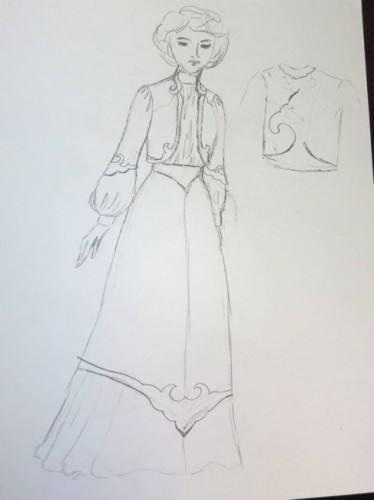
But they looked a little too…vulgar? Crude? (In most senses of the words.)
So I stuck with my original design inspiration. I sketched it out on to a piece of fabric laid out on the skirt, cut out my sketched shape, and pinned in on the skirt to get an idea of how it would look.
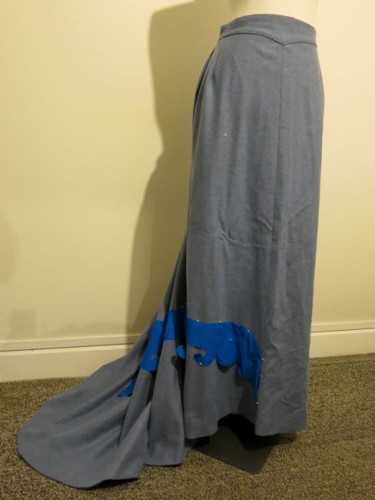
It’s a little more spread out and subtle than in the design sketch, but I think it works better that way as a real-life translation.
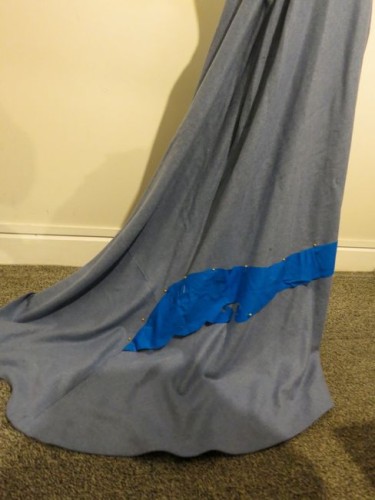
With the design sorted, I needed the fabric to make my applique shapes out of. I rummaged through the entire stash, but nothing seemed right, so it was time for a trip to the Asia Gallery (and a fervent prayer they had suitable obi in stock).
I actually came home with not one, but four obi that I thought might do:
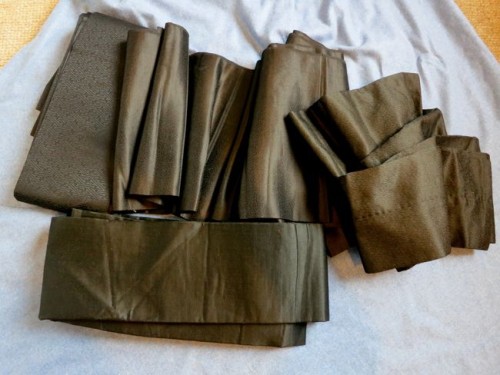
I’d really wanted a black silk satin with a small floral jacquard pattern, which I’ve seen in the past, but unfortunately they didn’t have anything of that description. So what I got was (from left): a meander pattern jacquard, a little curlicue jacquard, a textured jacquard, and a plain black satin. The last turned out to be a bit of a mistake: too old and fragile for me to do much with. Should have checked it better. But…the support fabric hidden under the satin is basically a coutil, so it was still worth the money!

I decided to go with the meander. I liked the way it marched with the blue better (the others are really old obi, so have a greenish tinge to the black dye), and I liked the way the meander pattern references the meander in the background of my cloud collar.
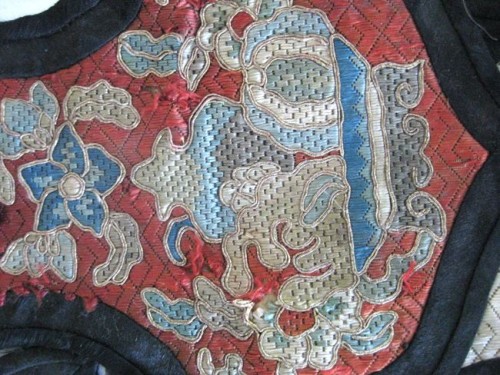
With my fabric picked, I laid out out my design pattern, and realised that the patterned portion of the obi wasn’t quite long enough to fit the skirt applique and the collar applique.
Oh, wailey, wailey wailey!
But I persevered, and rearranged, and turned and jiggled pieces, and found that by cutting the two back halves of the collar along the obi, instead of across it, I could make it work.
Hurrah!
So I laid out my pieces, added seam allowance, and cut them out.
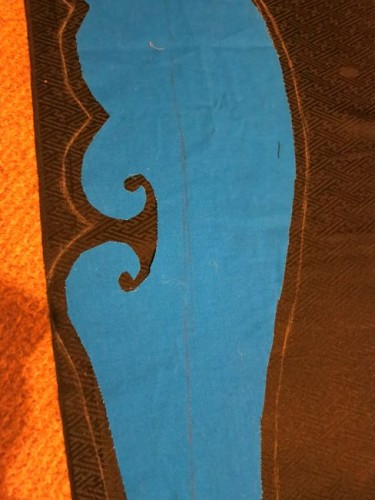
Felicity helped:
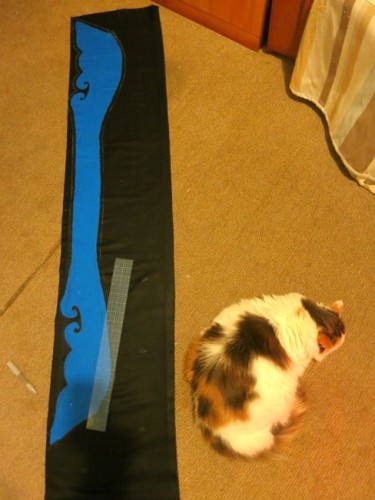
Then it was time for the making of the piping.
I cut bias strips. And more bias strips, and more bias strips.
Then I sewed bias strips together, and more bias strips together, and more to those.
Then I sewed my bias strips around my piping cord.
And sewed.
And sewed.
I made 17 and not-quite-a-half metres of black piping.
And 11 metres of ivory piping.
I also found out that my bobbins, on average, hold 17 and not-quite-a-half metres of thread, and that you can use up a bobbin in one continuous line of stitching.
I may have gone slightly overboard with the black piping.
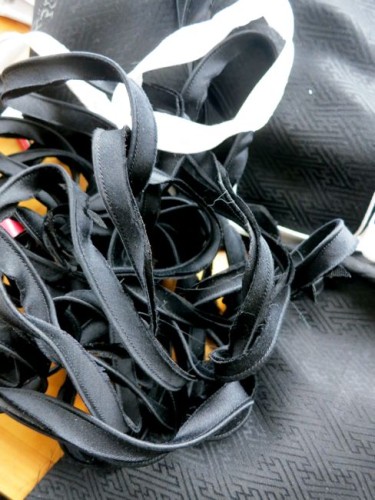
The piping is for finishing the edges of my applique. I didn’t think I had the patience (or, to be perfectly frank, the skill) to do the wide bias-bound borders that you see on the cloud collar, but my Chinese jacket is finished with teeny-tiny piping.
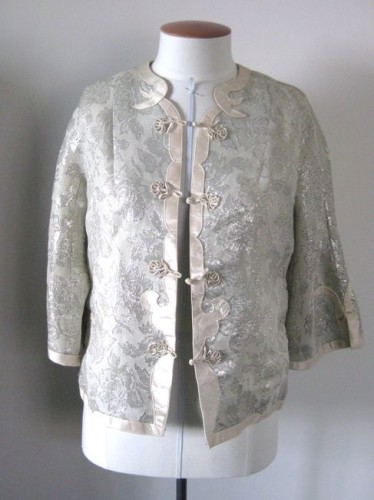
Jacket, silk & lame, mid-20th century, made in Hong Kong (probably)
I liked the idea of imitating the multiple layers of border finish that you see on many antique Chinese robes, and thought that two layers of piping would be a suitable Western nod to that. My inner layer of piping is ivory silk left over from Carolyn’s wedding dress, and my outer piping is plain black satin from the backing of the obi I am using for the main applique. Hurrah frugality!
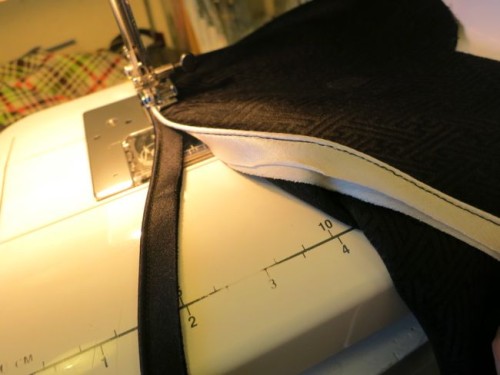
I sewed the ivory piping on first, turned and pressed it, and then sewed the black piping on, using the stitching to hold the whole thing flat and tidy.

On the lower edge of my skirt piece, I had to hand-sew the white piping around the tiny curved areas, because it was too finickity to do by machine. I used my pattern as a template for the sewing.
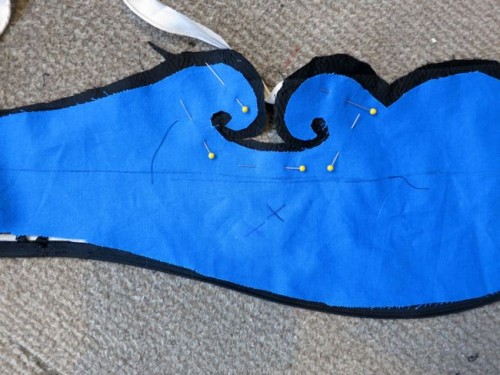
Now, to sew the panels to the skirt! I really, really want to post this on time on Monday!
Clearly the bodice isn’t going to happen in time, but I’ll still have the completed skirt, and I have fully drafted and fitted the bodice, so there has been progress, and I’ll keep working on it.

I love seeing you repurpose kimono and obi fabric for your garments — It is a great example of mottainai (not letting something to waste).
The meander pattern is called sayagata in Japanese, and is a pattern derived from interlocking manji. It arrived in Japan via China, originating in India — which is why you’ll see it a lot in both Chinese and Japanese textiles. http://immortalgeisha.com/wiki/index.php?title=Sayagata
I’m really looking forward to seeing how this turns out!
I like the term mottainai… much shorter than its usual counterparts in other languages. 🙂 (My family has already happily appropriated “umami” in the world of food.)
Leimomi, your method is fascinating… If you used only one line of piping, would you stitch it down, too?
Yes, it is a time consuming project, but it’s gorgeous. Think how spectacular it will be when it’s done.